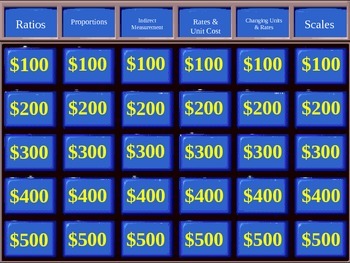Jeopardy Game for Ratios, Proportions, Indirect Measurement, Rates, Scales
Middle School Mathematics- Ken Dunlap
116 Followers
Grade Levels
6th - 8th
Subjects
Resource Type
Standards
CCSS6.RP.A.1
CCSS6.RP.A.2
CCSS6.RP.A.3
CCSS7.RP.A.1
CCSS7.RP.A.2
Formats Included
- PPT
Pages
63 pages
Middle School Mathematics- Ken Dunlap
116 Followers
Description
This Jeopardy game has 6 categories with 5 questions in each category. Categories include: Rations, Proportions, Rates and Unit Rates, Indirect Measurement, Scales, Converting Units and Rates. A solution is provided for each question.
Total Pages
63 pages
Answer Key
Included
Teaching Duration
N/A
Last updated Feb 3rd, 2014
Report this resource to TPT
Reported resources will be reviewed by our team. Report this resource to let us know if this resource violates TPT’s content guidelines.
Standards
to see state-specific standards (only available in the US).
CCSS6.RP.A.1
Understand the concept of a ratio and use ratio language to describe a ratio relationship between two quantities. For example, “The ratio of wings to beaks in the bird house at the zoo was 2:1, because for every 2 wings there was 1 beak.” “For every vote candidate A received, candidate C received nearly three votes.”
CCSS6.RP.A.2
Understand the concept of a unit rate 𝘢/𝘣 associated with a ratio 𝘢:𝘣 with 𝘣 ≠ 0, and use rate language in the context of a ratio relationship. For example, “This recipe has a ratio of 3 cups of flour to 4 cups of sugar, so there is 3/4 cup of flour for each cup of sugar.” “We paid $75 for 15 hamburgers, which is a rate of $5 per hamburger.”
CCSS6.RP.A.3
Use ratio and rate reasoning to solve real-world and mathematical problems, e.g., by reasoning about tables of equivalent ratios, tape diagrams, double number line diagrams, or equations.
CCSS7.RP.A.1
Compute unit rates associated with ratios of fractions, including ratios of lengths, areas and other quantities measured in like or different units. For example, if a person walks 1/2 mile in each 1/4 hour, compute the unit rate as the complex fraction ½/¼ miles per hour, equivalently 2 miles per hour.
CCSS7.RP.A.2
Recognize and represent proportional relationships between quantities.





